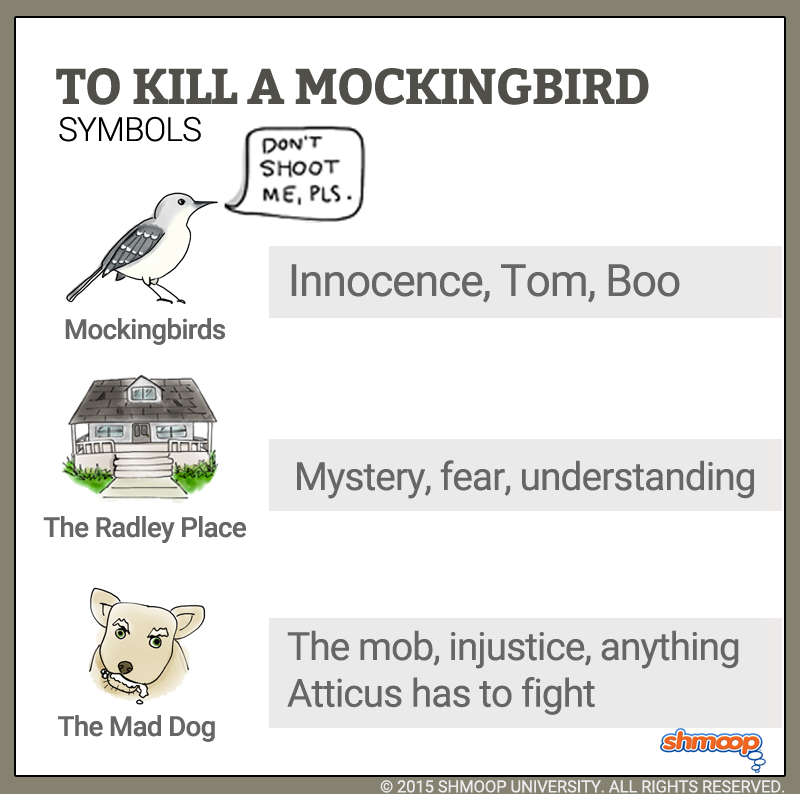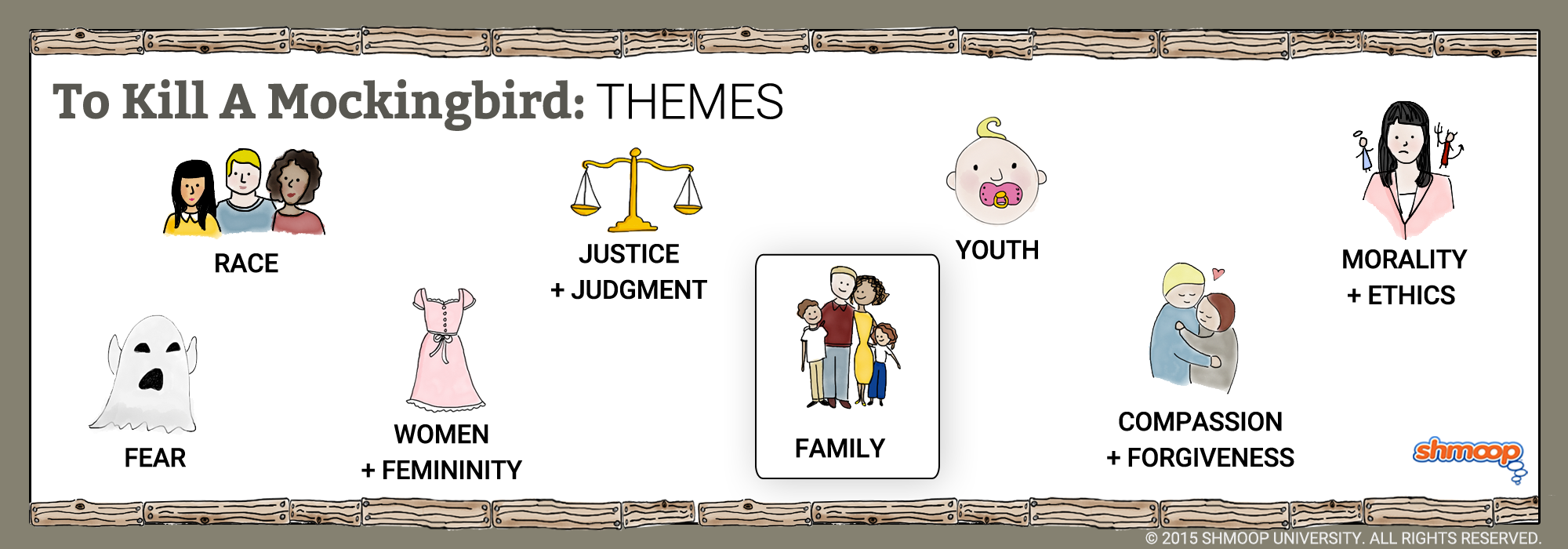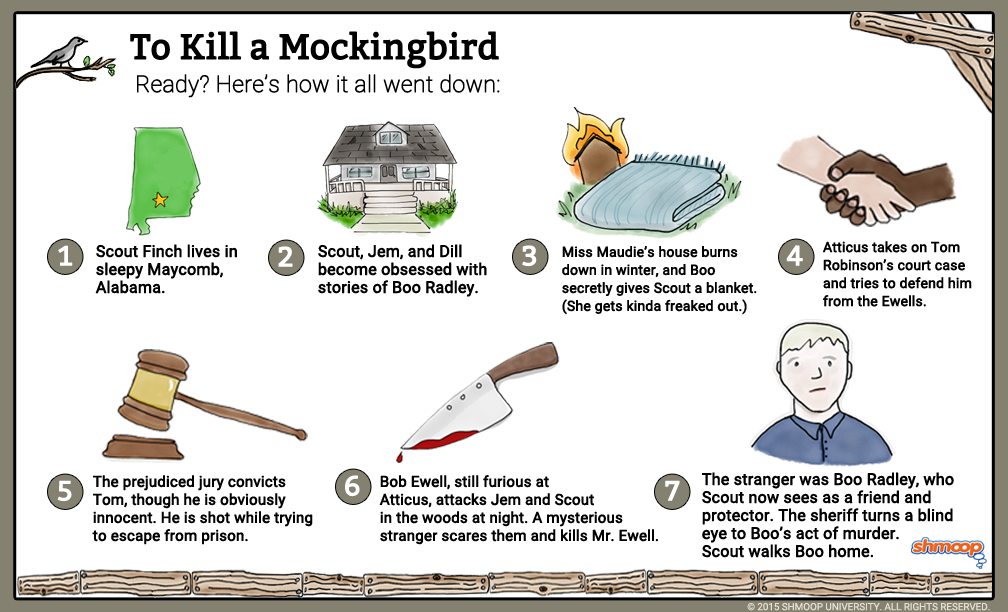To Kill a Mockingbird Character Analysis
Jean Louise ‘Scout’ Finch - The narrator and protagonist of the story. Jean Louise “Scout” Finch lives with her father, Atticus, her brother, Jem, and their black cook, Calpurnia, in Maycomb. She is intelligent and, by the standards of her time and place, a tomboy. As the novel opens, Scout is both innocent and intolerant of anything new or different. Scout has a combative streak and a basic faith in the goodness of the people in her community. As the novel progresses, her faith is tested by the hatred and prejudice that emerge during Tom Robinson’s trial. Through her father Atticus’ teaching, Scout learns the best way to respond to prejudice is to try to understand its origins, to relate to people in terms of their dignity rather than their anger, and to use that foundation as a way to try to slowly change their minds. Scout eventually develops a more grown-up perspective that enables her to appreciate human goodness without ignoring human evil.
Atticus Finch - Scout and Jem’s father, a lawyer in Maycomb descended from an old local family. A widower with a dry sense of humor, Atticus has instilled in his children his strong sense of morality and justice. He is one of the few residents of Maycomb committed to racial equality. When he agrees to defend Tom Robinson, a black man charged with raping a white woman, he exposes himself and his family to the anger of the white community. Yet as much as Atticus believes in acting morally, he does not believe in righteously condemning those who don't always act morally. Instead, Atticus teaches his children to search out and respect the dignity of every human being, to try to see the world from their individual point of view. With his strongly held convictions, wisdom, and empathy, Atticus functions as the novel’s moral backbone. Atticus Finch has become one of the great father figures in American literature.
Jeremy ‘Jem’ Finch - Scout’s brother and constant playmate at the beginning of the story. Jeremy ‘Jem’ Finch is something of a typical American boy, refusing to back down from dares and fantasizing about playing football. Intelligent and adventurous as a child, Jem never loses these qualities. Four years older than Scout, he gradually separates himself from her games, but he remains her close companion and protector throughout the novel. Jem moves into adolescence during the story, and grows into a young man who is strong, serious, idealistic, and sensitive. His ideals are shaken badly by the evil and injustice that he perceives during the trial of Tom Robinson. Jem also admires the justice and moral character that Atticus stands for, and which he wants to one day stand for himself.
Arthur ‘Boo’ Radley - A recluse who never sets foot outside his house, Boo dominates the imaginations of Jem, Scout, and Dill. Many rumors describe Arthur as a kind of monster who stabbed his father as a boy, eats cats, and haunts the neighborhood at night. He is a powerful symbol of goodness wrapped in an initial sort of creepiness, leaving little presents for Scout and Jem and emerging at an opportune moment to save the children. An intelligent child emotionally damaged by his cruel father, Boo provides an example of the threat that evil poses to innocence and goodness. He is one of the novel’s “mockingbirds,” a good person injured by the evil of mankind.
Charles Baker ‘Dill’ Harris - Jem and Scout’s summer neighbor and friend who visits from Meridian, Alabama. He is Rachel Haverford’s nephew. Dill is a diminutive, confident boy with an active imagination. He uses his imagination to hide loneliness and pain. He becomes fascinated with Boo Radley and represents the perspective of childhood innocence throughout the novel.
Bob Ewell - A drunk, mostly unemployed member of Maycomb’s poorest family. In his knowingly wrongful accusation that Tom Robinson raped his daughter, Ewell represents the dark side of the South: ignorance, poverty, filth, and hate-filled racial prejudice.
Calpurnia - The Finches’ black cook. Calpurnia is a stern disciplinarian and the children’s bridge between the white world and her own black community. Calpurnia may be an employee of Atticus Finch, but he treats her like family showing his morality towards prejudice.
Miss Maudie Atkinson - Finch’s neighbor. Old friend of the family. She shares Atticus’s passion for justice and is the children’s best friend among Maycomb’s adults.
Aunt Alexandria - Perfect southern lady. Fierce devotion to her family.
Mayella Ewell - Bob Ewell abused, lonely, and unhappy daughter.
Tom Robinson - The black field hand accused of rape. Tom is one of the novel’s “mockingbirds,” an important symbol of innocence destroyed by evil.
Link Deas - Tom Robinson’s employer. In his willingness to look past race and praise the integrity of Tom’s character, Deas epitomizes the opposite of prejudice.
Mrs. Henry Lafayette Dubose - An elderly, ill-tempered, racist woman who lives near the Finches. Although Jem believes that Mrs. Dubose is a thoroughly bad woman, Atticus admires her for the courage with which she battles her morphine addiction.
Nathan Radley - Boo Radley’s older brother. Nathan cruelly cuts off an important element of Boo’s relationship with Jem and Scout when he plugs up the knothole in which Boo leaves presents for the children.
Heck Tate - The sheriff of Maycomb and a major witness at Tom Robinson’s trial. Heck is a decent man who tries to protect the innocent from danger.
Mr. Underwood - The publisher of Maycomb’s newspaper. Mr. Underwood respects Atticus and proves his ally.
Mr. Dolphus Raymond - A wealthy white man who lives with his black mistress and mulatto (mixe) children. Raymond pretends to be a drunk so that the citizens of Maycomb will have an explanation for his behavior. In reality, he is simply tired of the hypocrisy of white society and prefers living among blacks.
Mr. Walter Cunningham - A poor farmer and part of the mob that seeks to lynch Tom Robinson at the jail. Mr. Cunningham displays his human goodness when Scout’s politeness compels him to disperse the men at the jail.
Walter Cunningham - Son of Mr. Cunningham and classmate of Scout. Walter cannot afford lunch one day at school and accidentally gets Scout in trouble.



